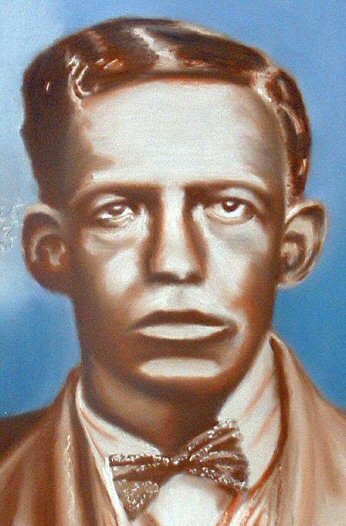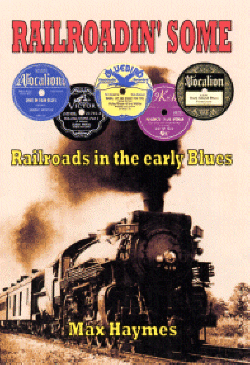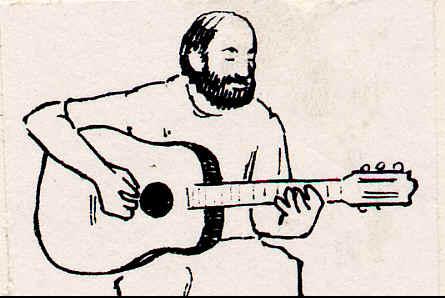
Painting © 2004 Loz
Arkle
Website
© Copyright 2000-2011 Alan White - All
Rights Reserved
Site optimised for Microsoft Internet Explorer
The Red Man and The Blues |
|
As I said in my introduction, the subject of connections between red and black races in the U.S. has been sparsely covered up until the present day; the question of links between the red man and the Blues singer, not at all. Yet, not only did inter-breeding take place from slavery times onwards, at a prolific rate between the two races, but in the case of many Blues singers, they wished to publicize the fact and were proud of their Indian ancestry. Albeit, for mainly socio-economic reasons, as we have seen. For many a Blues singer was also proud of his/her own 'blackness'. "I'm black and I'm evil an' I did not make myself" was a line echoed up and down the country by female and male singers alike. Taking the foregoing into consideration, it must be stated that many Blues singers claimed Indian descent without any verification whatsoever. They did so, not only for the socio-economic advantages, but also because they had a sneaking regard for another ethnic minority who suffered so much from the whites, in the latter's efforts to exterminate them, and yet managed somehow to survive. But other Blues singers such as Lowell Fulson, Roy Brown and Louisiana Red, for example, had actually taken pains to research into their past and proved their Indian lineage. Parts of Red Indian culture permeate that of the Blues singer. In the case of the 'medicine-bag' (Ch. IV), what had previously been thought to have been remnants of an earlier West African culture, turned out to be inherited from the native Americans. With the aid of further research, it might transpire that this is not an isolated example. By the many references in the Blues to the native Americans, it is obvious that the Blues singer regarded the red man as socially 'more acceptable' to the white man and therefore viewed marriage with 'an Indian squaw' as a definite advantage. Added to this fact was the Blues singers' concept, albeit a mis-guided one, of the generally wealthy status of Indians in Oklahoma. This was of course reinforced by the great oil-strikes on Indian-owned land in the earlier part of this century, and by the propaganda put out by the Bureau for Indian Affairs. That the Blues singer, and many working-class blacks who identified with them, saw the Nation as some sort of haven or emotional bolt-hole', has been well-demonstrated. Atlanta-based singer, Peg Leg Howell only reiterates this theme when he declares that he wants to go to "...Tishomingo the Chickasaw capitol," (1), in his blues named after this Indian town:
Tishomingo being situated in southeastern Oklahoma. Even on the record scene in the 1920's, one of the leading Blues record labels in the pre-war era, was called "Okeh", a division of Columbia Records. This is a Choctaw word from which O.K. is derived. But it "...does not mean "all correct"; it means that we have reached a point where practical agreement is possible, however far from perfection it may lie."(3). Though Ferguson and co. report that the word 'okay', amongst other examples, is "...posited as being of West African origin,"(4). However, in the case of 'O.K.', this would seem to be an obvious error. To be fair to Ferguson and Heath, they do add "...there are debates surrounding each of these items."(5). In the post-war era, the need to identify with Indian tribes continued. In a reproduction of an "Early '60's Buffalo Booking Agency poster,"(6), included in the Ike and Tina (Turner) Revue is a group called 'Mr. Lee and The Cherokees'. "Today there are over 190,000 people of Indian descent in the Southeast,"(7). The great majority of these are blacks. This further supports my contention that many Blues singers who have Indian blood, are so-connected to one or other of the Five Civilized Tribes, Choctaw, Chickasaw, Cherokee, Creek, or Seminole; and by extension these singers might also have/had vestiges of earlier tribes such as the Yuchis or Yamassees, running through their veins.
Notes 1. A. Debo. "Oklahoma Foot-Loose And Fancy Free."p.199. 2. "Tishamingo Blues."(sic). Peg Leg Howell (vo. gtr.). 8/11/26. Atlanta, Ga. 3. R.L. Nichols & G.R.Adams.p.32. 4. C.A. Ferguson & co.p.105. 5. Ibid. 6. "Red Lick".p.2. 7. J.D. Jennings & co.p.417._________________________________________________________________________
Website © Copyright 2001-2010 Alan White. All Rights Reserved. |







